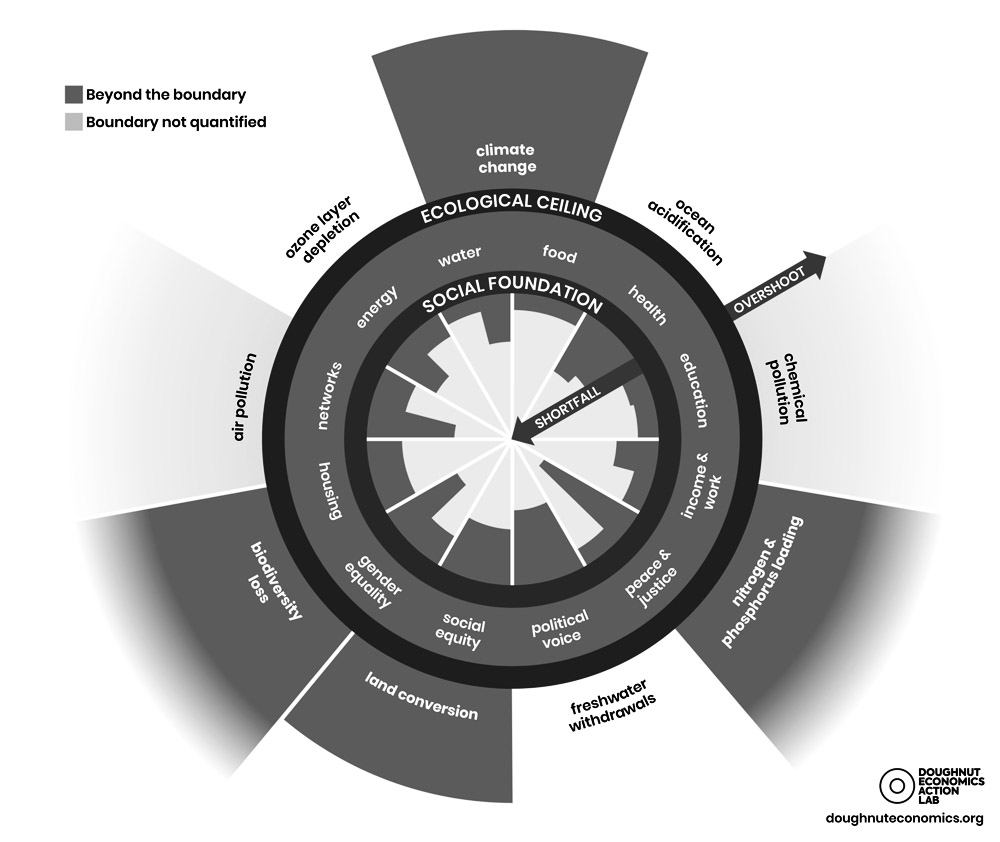
A bite-sized revolt
In 2011, “about 70 [Harvard] students walked out” of an economics class taught by professor Gregory Mankiw — former economics advisor to President George W. Bush, and author of widely-used textbooks in economics. The students were protesting the Harvard economist’s course and its supposed role in economic and social injustice. (Ironically, the topic of their lecture that day was income inequality.)
As Kate Raworth writes in Doughnut Economics, “no other academic discipline has managed to provoke its own students… [into] worldwide revolt”. While her comment is somewhat exaggerated, she has a point. Ivory tower economics is not serving society as well as it should.
Skip ahead
- A bite-sized revolt
- Enter the doughnut paradigm
- Seven ways to think like a 21st century economist
- Circular flows and giant slugs
- Markets and states, prices and nudges
- Gardening and monopoly
- The Keynesian challenge
Enter the doughnut paradigm
Kate Raworth herself wonders what economics might look like if we began “not with its long-established theories, but with humanity’s long-term goals”. What might happen if we focused less on social physics and more on the social good? When she pulled these disparate elements together, “it came out looking like a doughnut”.
Her mental model consists of two rings (Figure 1). Inside the inner ring is “the social foundation” — the “critical human deprivations” that we need to resolve as a society. This includes energy, water, food, health, education, housing, income, employment, peace and justice, political voice, social equity, gender equality, and so on.
Outside the outer ring is “the ecological ceiling” — the “critical planetary degradation” that we need to prevent as a society. This includes climate change, biodiversity loss, air pollution, ozone layer depletion, ocean acidification, and so on. The goal, of course, is to live inside the doughnut — to “meet the needs of all within the means of the planet”.
“The essence of the Doughnut: a social foundation of well-being that no one should fall below, and an ecological ceiling of planetary pressure that we should not go beyond. Between the two lies a safe and just space for all.”
Kate Raworth. (2017). Doughnut Economics.
Figure 1. The Doughnut of social and planetary boundaries

Seven ways to think like a 21st century economist
Most of us know that we are “transgressing both sides of the doughnut”. And given the manifold rise in population, output, energy use, and waste during this Great Acceleration, the magnitude of coordination and change necessary to bring us into balance is tremendous.
To meet this challenge, economic thinking, Raworth argues, needs to revise itself in seven ways. These ideas are not new to economists and their critics by any means. But they offer a helpful template and reminder on where reasoning ought to go.
Look at the big picture and complex systems
Firstly, we need to “see the big picture”. We have to go beyond the circular flow diagram of a self-contained market to an embedded economy that recognises, amongst other things, the household, the state, and the environment. It is a simple reminder that we live not only under a resource and budget constraint, but under an environmental and ecological limit too.
Secondly, we need to get “savvy with systems”. The modern economy is more than a deterministic machine in which prices adjust mechanically to bring supply and demand into equilibrium. Most of us will agree today that we live in a complex adaptive system. Feedback loops, networks, and hierarchies are the name of the game.
Understand and nurture human nature
Our models need to recognize the social aspects of human beings. We are not the homogenous, self-interested, all-seeing optimizers that economics traditionally assumes. Our sense of fairness, fluidity in values, diversity in culture, and tendency for reciprocity do not conform to standard models.
This brings us to Raworth’s third point — the need to “nurture human nature”. Beliefs shape actions, and actions shape beliefs. It can be a virtuous or vicious cycle. Indeed, beliefs in the efficiency of cut-throat, self-interested, profit-seeking capitalists is one thing. But is this the world and culture we want for our children?
Design to distribute and create to regenerate
Moreover, simplistic notions of trickle-down economics do not suffice. Market failures, prisoner’s dilemmas, and financial crashes remind us that there is no guarantee that an economy left to its own devices will bring prosperity to everyone.
To Raworth’s fourth and fifth point, economic thinking must “design to distribute” and “create to regenerate”. Income inequality, social injustice, and environmental degradation is “a design failure”. The idea that we can simply outgrow a system out-of-balance is a false premise.
Change the goal and be growth agnostic
This brings us to Raworth’s sixth requirement to “change the goal”. Indeed, growth in gross domestic product remains the most headline grabbing measure of national progress. While undoubtedly important, its overemphasis may detract from other priorities on our economic doughnut.
But finding better measures that are easy to communicate is harder than it sounds. Indeed, while 193 countries have adopted the United Nations Sustainable Development Agenda, with 17 goals and 169 targets, details of these ambitions, in my opinion, are yet to really consume public discourse and galvanize political attention.
If changing the goal isn’t hard enough, Raworth’s seventh idea — to move from a growth addicted to growth agnostic society — might prove insurmountable. For strength in enterprise and geopolitics depends in part on relative size and relative growth by extension. And so the rat race for supremacy, both in commerce and politics, continues.
But if you agree that economies, like everything else in nature, cannot grow to infinity, then reform and coordination is necessary. This isn’t a call, however, for global centralized planning. Respecting the complexity and networks of society, doughnut economics demands a mixture of solutions from governments, markets, technology, communities, and families.
Circular flows and giant slugs
Some economic students might be familiar with the MONIAC (Monetary National Income Analogue Computer). It is a hydraulic system that Bill Phillips designed in 1949 to visualize the circular flow of income with colored fluids. Many universities used it as a novelty to demonstrate ideas in macroeconomic theory.
Raworth emphasizes, however, that such a mental model is incomplete. The economy “is not [only] a roundabout of money but… a one-way street of energy” — “nothing can move, grow or work without using that energy”. The MONIAC, likewise, is not a perpetual machine. It needs electricity from an external source to push its water around (and generating heat in turn).
This “invites us”, Raworth says, “to imagine the economy as a superorganism” — a sort of “giant slug that demands continual intake of matter and energy from Earth’s sources, and delivers a continual stream of waste matter and waste heat into its sinks”. (Personally, I prefer the parallels to social insects, but the point of Raworth’s analogy stands.)
Markets and states, prices and nudges
Like the chemical networks of an ant colony, Adam Smith showed how our price system coordinates scores of motivated buyers and sellers in a decentralized yet efficient manner. Indeed, leaving tacit responsibilities and knowledge to the lumbering state tends to result in undersupply and misallocation.
But prices aren’t always almighty either. For example, according to Richard Titmuss in The Gift Relationship, to secure an adequate supply of blood for transfusions, altruistic-donor-systems seem to perform better than for-profit markets for blood. As Dan Ariely notes in Predictably Irrational, people respond to social and economic norms and transactions differently.
The boons of capitalism have certainly promulgated the free market spirit. But no market is truly free in the literal sense of the word. The health of any social system depends mightily on the institutions, organization, and talent that underpins it. Perhaps there is a doughnut here as well — rings for state control and market efficacy.
To motivate change, we may have to think beyond markets and prices to focus on “reciprocity, values, nudging, and networks”. This is particularly so for complex challenges like climate change, where the consequences are “invisible, delayed, gradual and distant” — “characteristics that our heuristic decision tools are infamously bad at handling well”, Raworth reminds.
Gardening and monopoly
The modern attitude to economics, Raworth adds, should be less like mechanics at an auto shop and “more like gardeners tending [to] their plants”. The difference here is between static fine-tuning and open cultivation. “Economic gardeners must get stuck in, nurturing, selecting, repotting,… pruning and weeding the plants as they grow and mature”.
Gardeners, you see, focus not only on outward growth, but on the systems deep underground. They care about the distribution and quality of nutrients, sunlight, and water that their plants receive. Indeed, if we are interested in tending to our social and economic systems, we have to pay attention to the underlying dynamics.
One particular dynamic, Raworth highlights, are “power relationships”. Most of us, I’m sure, are familiar with the wealth disparities between wage earners and the owners of capital. Like the board game Monopoly, social mobility, wealth and power tends to be mutually self-reinforcing.
I’d generalize further by saying that we do not yet, to my knowledge, have a compelling, user-friendly theory on the ecology of power. That is, a framework to talk about how power might consolidate, erode, and divide over time, both in economics and politics.
The Keynesian challenge
In A Tract on Monetary Reform, John Maynard Keynes laments that “economists set themselves too easy, too useless a task, if in tempestuous seasons they can only tell us that when the storm is long past the ocean is flat again”.
Similarly, almost a century later in Factfulness: Ten Reasons We’re Wrong About the World, Hans Rosling reminds us that “misconceptions disappear only if there is some equally simple but more relevant way of thinking to replace them.”
Both remarks apply to current criticisms of economics as well. Indeed, it is much easier to dwell on thinking errors and broad directions than to build a more complete model of the world. Like a weak New Year’s resolution, it is the difference between aspiration and actual action.
In this way, Doughnut Economics is only a starting point. More work is necessary to integrate our understanding of economics with society and the environment. We need better models to supplant the tools that have preoccupied mainstream economics for decades.
Finally, most economists and politicians aren’t bumbling fools or evil plotters. Most of them are well aware of the academic and real world problems at hand. The challenge is in getting useful work done. And getting things done is hard with a global society as big and clunky as ours.
A thousand more books and blog posts on the matter is unlikely to move things. Progress must happen on the floor where micro incentives and social frictions manifest. What we need then are advances in the knowhow of institutions and coordination. That too is easier said than done.
Sources and further reading
- Raworth, Kate. (2017). Doughnut Economics.
- Rosling, Hans. (2018). Factfulness.
- Keynes, John Maynard. (1923). A Tract on Monetary Reform.
- Titmuss, Richard. (1970). The Gift Relationship.
Latest posts
- What’s Eating the Universe? Paul Davies on Cosmic Eggs and Blundering Atoms
- The Dragons of Eden — Carl Sagan on Limbic Doctrines and Our Bargain with Nature
- The Unexpected Universe — Loren Eiseley on Star Throwers and Incidental Triumphs
- Bridges to Infinity — Michael Guillen on the Boundlessness of Life and Discovery
- Ways of Being — James Bridle on Looking Beyond Human Intelligence
- Predicting the Unpredictable — W J Firth on Chaos and Coexistence
- Order Out of Chaos — Prigogine and Stenger on Our Dialogue With Complexity
- How Brains Think — William Calvin on Intelligence and Darwinian Machines
- The Lives of a Cell — Lewis Thomas on Embedded Nature
- Infinite in All Directions — Freeman Dyson on Maximum Diversity